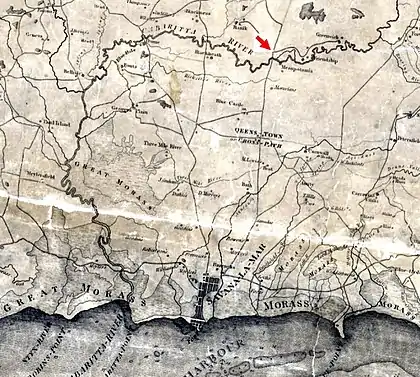Mesopotamia, Jamaica
Mesopotamia was a sugar plantation in Westmoreland Parish, Jamaica, north of Savanna-la-Mar[2] on the Cabaritta River. It was adjacent to the Friendship and Greenwich estate.

Mesopotamia plantation (arrowed) on James Robertson's map of 1804.[1]
History
The plantation was established around 1700 and according to official returns was one of 23 sugar plantations in the parish that employed over 200 slaves.[3]
It was associated with the Barham family. It was first in the ownership of Dr Henry Barham (c.1728-1746) and subsequently Joseph Foster Barham (c.1746-1789) and Joseph Foster Barham II (c.1789-1832).
The chemist John Buddle Blyth was baptised at Mesopotamia in 1816.[4][5] His father John Blythe was attorney for Mesopotamia in the early 19th-century.[6]
See also
References
- James Robertson map of 1804. National Library of Scotland. 16 January 2019.
- Mesopotamia Plantation, Savanna-la-Mar, Westmoreland, Jamaica. Geni. Retrieved 16 January 2019.
- "Sugar Production and Slave Women in Jamaica" by Richard S. Dunn in Ira Berlin & Philip D. Morgan (Eds.) (1993). Cultivation and Culture: Labor and the Shaping of Slave Life in the Americas. Charlottesville: University Press of Virginia. pp. 49–72 (p. 52). ISBN 978-0-8139-1424-4.
- John Buddle Blyth Jamaica, Church of England Parish Register Transcripts, 1664-1880. Family Search. Retrieved 16 January 2019. (subscription required)
- John Blyth. Legacies of British Slave-ownership, University College London. Retrieved 16 January 2019.
- Mesopotamia. University College London. Retrieved 16 January 2019.
External links
This article is issued from Wikipedia. The text is licensed under Creative Commons - Attribution - Sharealike. Additional terms may apply for the media files.